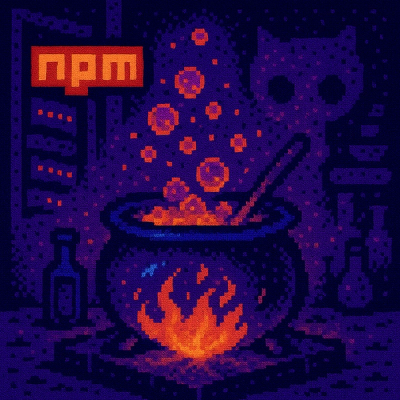
Security News
How Enterprise Security Is Adapting to AI-Accelerated Threats
Socket CTO Ahmad Nassri discusses why supply chain attacks now target developer machines and what AI means for the future of enterprise security.
vss-web-extension-sdk
Advanced tools
Visual Studio Team Services web extension JavaScript library and types.
Client SDK and TypeScript declare files for developing Visual Studio Team Services Extensions.
The core SDK script, VSS.SDK.js, enables web extensions to communicate to the host Team Services frame and to perform operations like initializing, notifying extension is loaded or getting context about the current page.
A previous version of the SDK was named
vss-sdk. Make sure to switch to the newvss-web-extension-sdkname.
npm install vss-web-extension-sdk from the root of your extension projectThis will place VSS.SDK.js and VSS.SDK.min.js in node_modules/vss-web-extension-sdk/lib/
If you are developing a web extension, you will need to reference the SDK script from your HTML pages. For example:
<script src="lib/VSS.SDK.min.js"></script>
To ensure the SDK script is packaged with your extension, update your extension manifest (typically vss-extension.json) and add a new entry to files:
{
"files": [{
"path": "node_modules/vss-web-extension-sdk/lib",
"addressable": true,
"packagePath": "lib"
}]
}
Note: setting packagePath is optional, but results in a simpler path for referencing the SDK script from your HTML pages. Not setting a part name would have required you to reference the full path in your <script> tag (src="node_modules/vss-web-extension-sdk/lib/VSS.SDK.min.js")
From your web extension's HTML page, include and initialize the VSS SDK like this:
<script>
// Initialize
VSS.init({
usePlatformScripts: true,
usePlatformStyles: true
});
// Register callback to get called when initial handshake completed
VSS.ready(function() {
// Start using VSS
});
</script>
Full API reference of VSS.SDK.js can be found at Core Client SDK page.
Type definitions are provided for:
typings/vss.d.ts)typings/tfs.d.ts)typings/rmo.d.ts)Dependency graph:

From a TypeScript 2.5 or later project:
"moduleResolution": "node" in your tsconfig.json project fileSee TypeScript Module Resolution for more details.
Alternatively, you can explicitly reference the types at the top of your TypeScript file(s):
/// <reference types="vss-web-extension-sdk" />
If you are developing a web extension for Visual Studio Team Service using TypeScript, we recommend the following organization:
|-- src
|-- app.ts
|-- some-module
|-- a.ts
|-- b.ts
|-- static
|-- css
|-- main.css
|-- images
|-- logo.png
|-- app.html
|-- vss-extension.json
|-- package.json
|-- tsconfig.json
srcstatic
tsconfig.json)Defines the options for compiling your TypeScript files.
{
"compilerOptions": {
"module": "amd",
"moduleResolution": "node",
"target": "es5",
"rootDir": "src/",
"outDir": "dist/",
"types": [
"vss-web-extension-sdk"
]
}
}
After compiling (tsc -p .), resulting .js files are placed in dist. For example, dist/app.js.
If your code directly uses types from other @types modules, you will want to include the module(s) in your package.json and add them to the types array. See @types.
Learn more about tsconfig.json
package.json)Declares the libraries (like the vss-web-extension-sdk) required to compile, package, and use your extension.
{
/* other details like ID, version, etc are omitted */
"scripts": {
"build": "tsc -p .",
"postbuild": "npm run package",
"package": "tfx extension create",
"gallery-publish": "tfx extension publish --rev-version",
"clean": "rimraf ./dist && rimraf ./*.vsix"
},
"devDependencies": {
"rimraf": "^2.5.4",
"tfx-cli": "^0.3.45",
"typescript": "^2.1.4"
},
"dependencies": {
"@types/jquery": "^2.0.34",
"@types/q": "0.0.32",
"vss-web-extension-sdk": "^5.127.0"
}
}
scripts provides a convenient way to define common operations that you want to perform on your project, like compiling and packaging.
npm run build. This runs build and postbuild. If you make a change that doesn't require compiling, you can package by simply running npm run package.postbuild script to run the gallery-publish script (instead of package). You can then run npm run build -- --token xxxxxx (where xxxx is you personal access token for publishing to the Marketplace) to build, package, and publish your extension.jquery and q are only necessary if your TypeScript code is directly referencing either of these types.Learn more about package.json
vss-extension.json){
/* details omitted */
"files": [
{
"path": "dist",
"addressable": true
},
{
"path": "static",
"addressable": true
},
{
"path": "node_modules/vss-web-extension-sdk/lib",
"addressable": true,
"packagePath": "lib"
}
],
"contributions": [
{
"id": "my-hub",
"type": "ms.vss-web.hub",
"properties": {
"name": "Hub",
"uri": "static/app.html"
}
}
]
}
The compiled JavaScript files (placed into dist by your tsconfig.json) will be packaged into the dist folder of the extension package.
The VSS SDK scripts will be packaged into the lib folder of the extension package.
Learn more about the extension manifest.
<head>
<script src="../lib/VSS.SDK.min.js"></script>
<!--
Alternatively, if the packagePath attribute is not set for this file in your extension manifest (see above), do this:
<script src="../node_modules/vss-web-extension-sdk/lib/VSS.SDK.min.js"></script>
-->
</head>
<body>
<script type="text/javascript">
// Initialize the VSS sdk
VSS.init({
usePlatformScripts: true,
usePlatformStyles: true
});
VSS.require(["dist/app"], function (app) {
...
});
</script>
</body>
This project has adopted the Microsoft Open Source Code of Conduct. For more information see the Code of Conduct FAQ or contact opencode@microsoft.com with any additional questions or comments.
FAQs
Visual Studio Team Services web extension JavaScript library and types.
The npm package vss-web-extension-sdk receives a total of 1,205 weekly downloads. As such, vss-web-extension-sdk popularity was classified as popular.
We found that vss-web-extension-sdk demonstrated a not healthy version release cadence and project activity because the last version was released a year ago. It has 1 open source maintainer collaborating on the project.
Did you know?

Socket for GitHub automatically highlights issues in each pull request and monitors the health of all your open source dependencies. Discover the contents of your packages and block harmful activity before you install or update your dependencies.

Security News
Socket CTO Ahmad Nassri discusses why supply chain attacks now target developer machines and what AI means for the future of enterprise security.

Security News
Learn the essential steps every developer should take to stay secure on npm and reduce exposure to supply chain attacks.

Security News
Experts push back on new claims about AI-driven ransomware, warning that hype and sponsored research are distorting how the threat is understood.